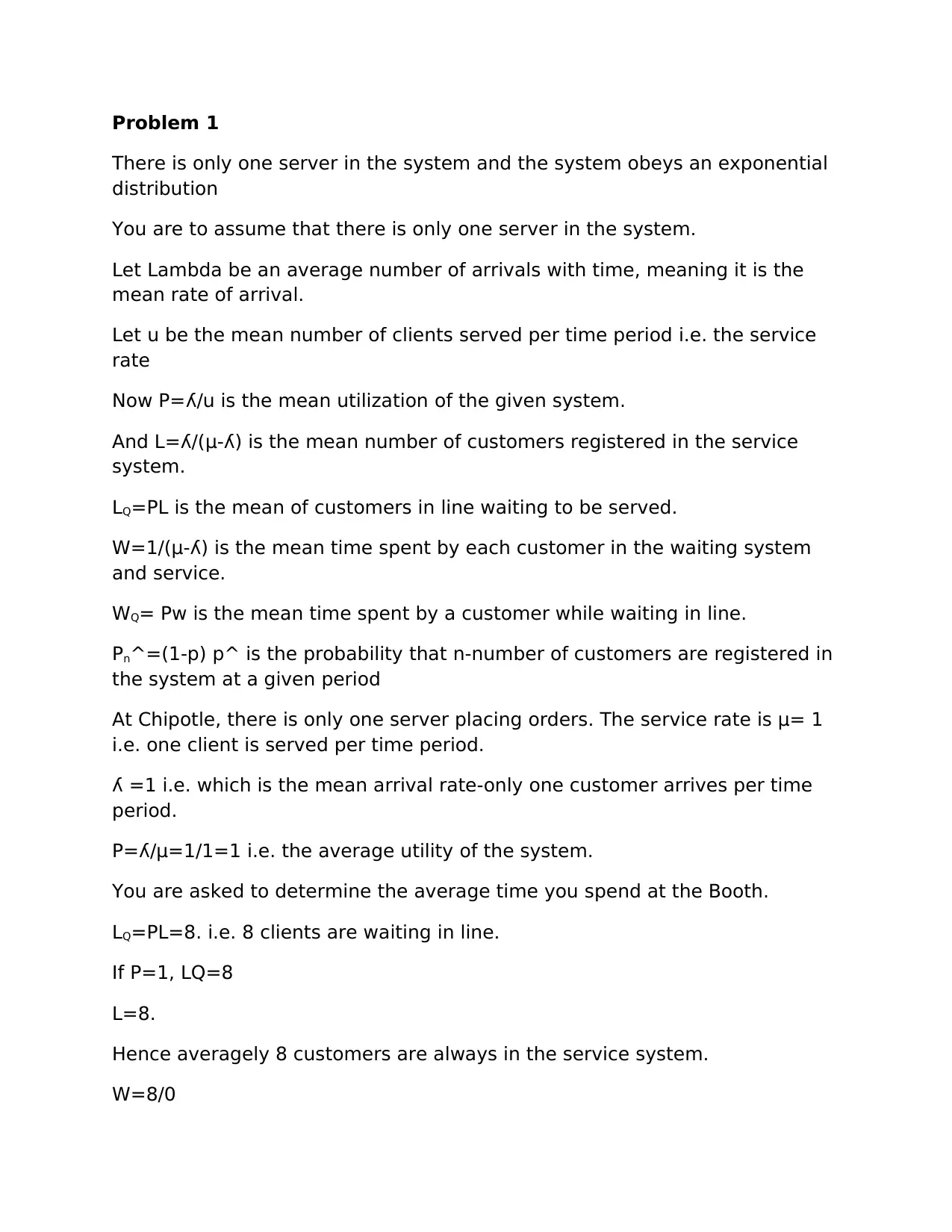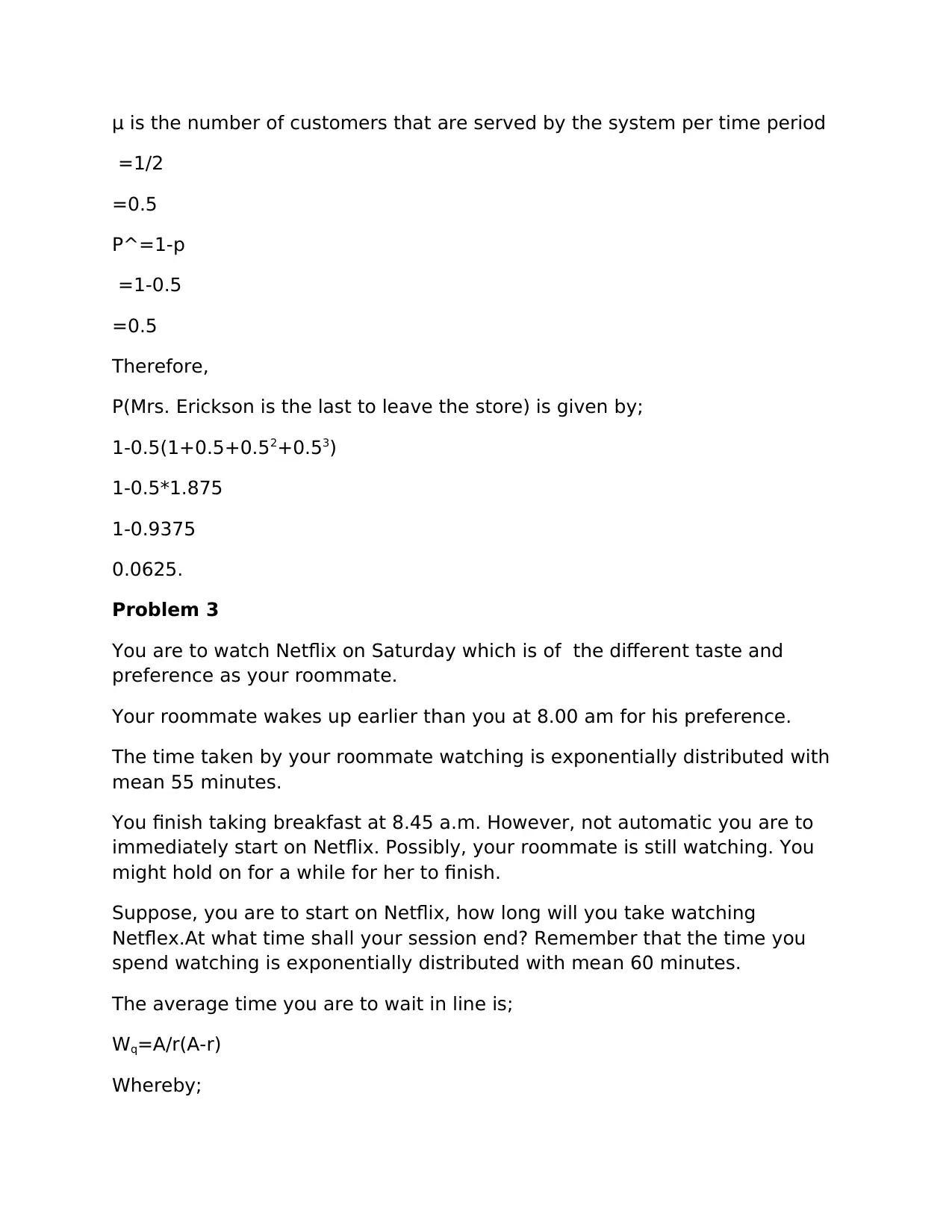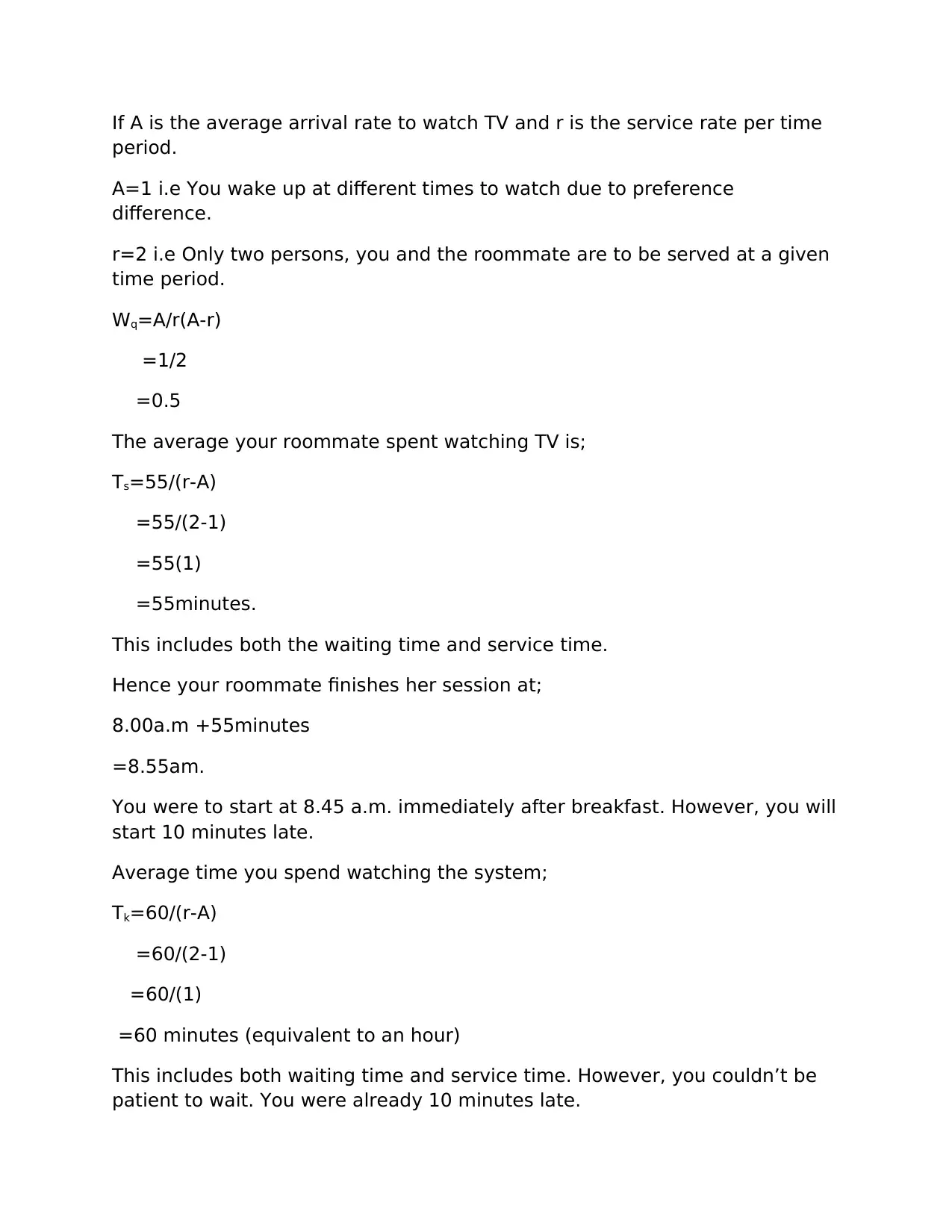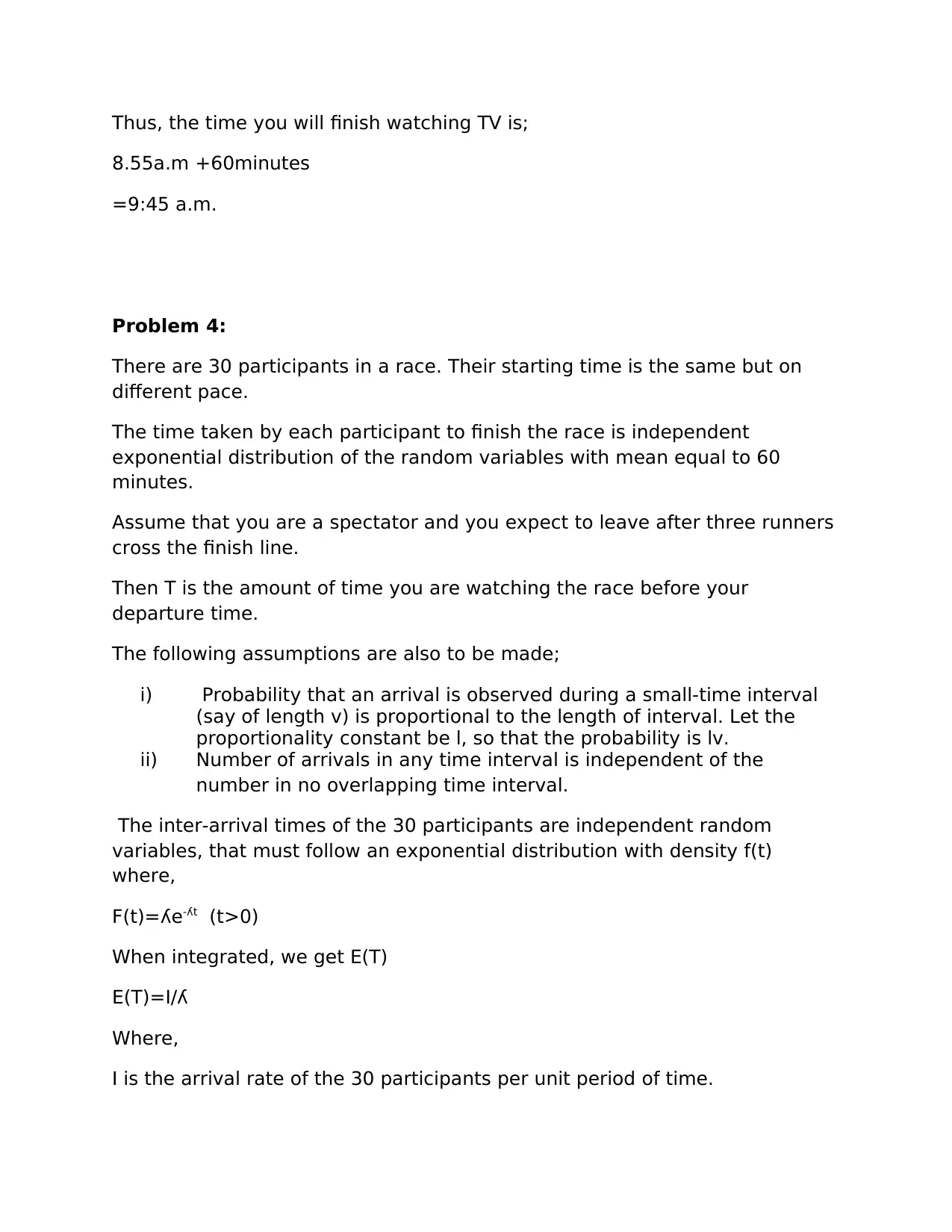University IOE 316 Winter 2019 Homework 4: System Analysis
VerifiedAdded on 2023/01/10
|6
|1213
|40
Homework Assignment
AI Summary
This document provides a detailed solution to IOE 316 Homework 4, addressing queueing theory and probability problems. The first problem analyzes a Chipotle scenario with one server, calculating waiting times using Little's Law and exponential distributions. The second problem explores a Trader Joe's scenario with two counters, calculating the probability of Mrs. Erickson being the last to leave. The third problem examines a Netflix scenario with two users, calculating waiting and service times, considering different wake-up times. The final problem analyzes a race with 30 participants, using exponential distributions to determine spectator departure time. The solutions involve calculations of arrival rates, service rates, probabilities, and expected waiting times, showcasing the application of queueing theory in various real-world scenarios.

Problem 1
There is only one server in the system and the system obeys an exponential
distribution
You are to assume that there is only one server in the system.
Let Lambda be an average number of arrivals with time, meaning it is the
mean rate of arrival.
Let u be the mean number of clients served per time period i.e. the service
rate
Now P=ʎ/u is the mean utilization of the given system.
And L=ʎ/(μ-ʎ) is the mean number of customers registered in the service
system.
LQ=PL is the mean of customers in line waiting to be served.
W=1/(μ-ʎ) is the mean time spent by each customer in the waiting system
and service.
WQ= Pw is the mean time spent by a customer while waiting in line.
Pn^=(1-p) p^ is the probability that n-number of customers are registered in
the system at a given period
At Chipotle, there is only one server placing orders. The service rate is μ= 1
i.e. one client is served per time period.
ʎ =1 i.e. which is the mean arrival rate-only one customer arrives per time
period.
P=ʎ/μ=1/1=1 i.e. the average utility of the system.
You are asked to determine the average time you spend at the Booth.
LQ=PL=8. i.e. 8 clients are waiting in line.
If P=1, LQ=8
L=8.
Hence averagely 8 customers are always in the service system.
W=8/0
There is only one server in the system and the system obeys an exponential
distribution
You are to assume that there is only one server in the system.
Let Lambda be an average number of arrivals with time, meaning it is the
mean rate of arrival.
Let u be the mean number of clients served per time period i.e. the service
rate
Now P=ʎ/u is the mean utilization of the given system.
And L=ʎ/(μ-ʎ) is the mean number of customers registered in the service
system.
LQ=PL is the mean of customers in line waiting to be served.
W=1/(μ-ʎ) is the mean time spent by each customer in the waiting system
and service.
WQ= Pw is the mean time spent by a customer while waiting in line.
Pn^=(1-p) p^ is the probability that n-number of customers are registered in
the system at a given period
At Chipotle, there is only one server placing orders. The service rate is μ= 1
i.e. one client is served per time period.
ʎ =1 i.e. which is the mean arrival rate-only one customer arrives per time
period.
P=ʎ/μ=1/1=1 i.e. the average utility of the system.
You are asked to determine the average time you spend at the Booth.
LQ=PL=8. i.e. 8 clients are waiting in line.
If P=1, LQ=8
L=8.
Hence averagely 8 customers are always in the service system.
W=8/0
Paraphrase This Document
Need a fresh take? Get an instant paraphrase of this document with our AI Paraphraser

μ=ʎ Hence the waiting line would infinitely grow large.
WQ=8*1
=8
The average time taken at a Booth is
=The average time spent waiting in line service time.
=8+1
9minutes.
The average time taken by a customer to order a ticket at the booth is 9
minutes.
Problem 2.
Mrs. Erickson has decided to buy grocery at Trader Joe’s store. She is to be
served by either counter 1 or counter being that there are two counters.
There are two servers to serve a customer at a time. Mrs. Erickson was to
checkout when both counters are on service, hence has to wait.
The two counters i.e. i=1,2 obeys an exponential rate ʎi
You are asked to determine the probability that Mrs. Erickson would be the
last to leave the store from among the three clients.
The probability that Mrs. Erickson would be the last to leave the store is one
minus the probability that client at counter 1 is the first to leave and client at
counter 2 the second to leave and Mrs. Erickson the last to leave or the client
at counter 2 is the first to leave and client at counter 1 the second to leave
and Mrs. Erickson the last to leave.
This is given by;
P=1-∑30Pn
=1-∑30(1-p)p^
The average utilization Is given by;
P=ʎ/μ
Where is the number of customers that arrive per time and?
WQ=8*1
=8
The average time taken at a Booth is
=The average time spent waiting in line service time.
=8+1
9minutes.
The average time taken by a customer to order a ticket at the booth is 9
minutes.
Problem 2.
Mrs. Erickson has decided to buy grocery at Trader Joe’s store. She is to be
served by either counter 1 or counter being that there are two counters.
There are two servers to serve a customer at a time. Mrs. Erickson was to
checkout when both counters are on service, hence has to wait.
The two counters i.e. i=1,2 obeys an exponential rate ʎi
You are asked to determine the probability that Mrs. Erickson would be the
last to leave the store from among the three clients.
The probability that Mrs. Erickson would be the last to leave the store is one
minus the probability that client at counter 1 is the first to leave and client at
counter 2 the second to leave and Mrs. Erickson the last to leave or the client
at counter 2 is the first to leave and client at counter 1 the second to leave
and Mrs. Erickson the last to leave.
This is given by;
P=1-∑30Pn
=1-∑30(1-p)p^
The average utilization Is given by;
P=ʎ/μ
Where is the number of customers that arrive per time and?

μ is the number of customers that are served by the system per time period
=1/2
=0.5
P^=1-p
=1-0.5
=0.5
Therefore,
P(Mrs. Erickson is the last to leave the store) is given by;
1-0.5(1+0.5+0.52+0.53)
1-0.5*1.875
1-0.9375
0.0625.
Problem 3
You are to watch Netflix on Saturday which is of the different taste and
preference as your roommate.
Your roommate wakes up earlier than you at 8.00 am for his preference.
The time taken by your roommate watching is exponentially distributed with
mean 55 minutes.
You finish taking breakfast at 8.45 a.m. However, not automatic you are to
immediately start on Netflix. Possibly, your roommate is still watching. You
might hold on for a while for her to finish.
Suppose, you are to start on Netflix, how long will you take watching
Netflex.At what time shall your session end? Remember that the time you
spend watching is exponentially distributed with mean 60 minutes.
The average time you are to wait in line is;
Wq=A/r(A-r)
Whereby;
=1/2
=0.5
P^=1-p
=1-0.5
=0.5
Therefore,
P(Mrs. Erickson is the last to leave the store) is given by;
1-0.5(1+0.5+0.52+0.53)
1-0.5*1.875
1-0.9375
0.0625.
Problem 3
You are to watch Netflix on Saturday which is of the different taste and
preference as your roommate.
Your roommate wakes up earlier than you at 8.00 am for his preference.
The time taken by your roommate watching is exponentially distributed with
mean 55 minutes.
You finish taking breakfast at 8.45 a.m. However, not automatic you are to
immediately start on Netflix. Possibly, your roommate is still watching. You
might hold on for a while for her to finish.
Suppose, you are to start on Netflix, how long will you take watching
Netflex.At what time shall your session end? Remember that the time you
spend watching is exponentially distributed with mean 60 minutes.
The average time you are to wait in line is;
Wq=A/r(A-r)
Whereby;
⊘ This is a preview!⊘
Do you want full access?
Subscribe today to unlock all pages.

Trusted by 1+ million students worldwide

If A is the average arrival rate to watch TV and r is the service rate per time
period.
A=1 i.e You wake up at different times to watch due to preference
difference.
r=2 i.e Only two persons, you and the roommate are to be served at a given
time period.
Wq=A/r(A-r)
=1/2
=0.5
The average your roommate spent watching TV is;
Ts=55/(r-A)
=55/(2-1)
=55(1)
=55minutes.
This includes both the waiting time and service time.
Hence your roommate finishes her session at;
8.00a.m +55minutes
=8.55am.
You were to start at 8.45 a.m. immediately after breakfast. However, you will
start 10 minutes late.
Average time you spend watching the system;
Tk=60/(r-A)
=60/(2-1)
=60/(1)
=60 minutes (equivalent to an hour)
This includes both waiting time and service time. However, you couldn’t be
patient to wait. You were already 10 minutes late.
period.
A=1 i.e You wake up at different times to watch due to preference
difference.
r=2 i.e Only two persons, you and the roommate are to be served at a given
time period.
Wq=A/r(A-r)
=1/2
=0.5
The average your roommate spent watching TV is;
Ts=55/(r-A)
=55/(2-1)
=55(1)
=55minutes.
This includes both the waiting time and service time.
Hence your roommate finishes her session at;
8.00a.m +55minutes
=8.55am.
You were to start at 8.45 a.m. immediately after breakfast. However, you will
start 10 minutes late.
Average time you spend watching the system;
Tk=60/(r-A)
=60/(2-1)
=60/(1)
=60 minutes (equivalent to an hour)
This includes both waiting time and service time. However, you couldn’t be
patient to wait. You were already 10 minutes late.
Paraphrase This Document
Need a fresh take? Get an instant paraphrase of this document with our AI Paraphraser

Thus, the time you will finish watching TV is;
8.55a.m +60minutes
=9:45 a.m.
Problem 4:
There are 30 participants in a race. Their starting time is the same but on
different pace.
The time taken by each participant to finish the race is independent
exponential distribution of the random variables with mean equal to 60
minutes.
Assume that you are a spectator and you expect to leave after three runners
cross the finish line.
Then T is the amount of time you are watching the race before your
departure time.
The following assumptions are also to be made;
i) Probability that an arrival is observed during a small-time interval
(say of length v) is proportional to the length of interval. Let the
proportionality constant be l, so that the probability is lv.
ii) Number of arrivals in any time interval is independent of the
number in no overlapping time interval.
The inter-arrival times of the 30 participants are independent random
variables, that must follow an exponential distribution with density f(t)
where,
F(t)=ʎe-ʎt (t>0)
When integrated, we get E(T)
E(T)=I/ʎ
Where,
I is the arrival rate of the 30 participants per unit period of time.
8.55a.m +60minutes
=9:45 a.m.
Problem 4:
There are 30 participants in a race. Their starting time is the same but on
different pace.
The time taken by each participant to finish the race is independent
exponential distribution of the random variables with mean equal to 60
minutes.
Assume that you are a spectator and you expect to leave after three runners
cross the finish line.
Then T is the amount of time you are watching the race before your
departure time.
The following assumptions are also to be made;
i) Probability that an arrival is observed during a small-time interval
(say of length v) is proportional to the length of interval. Let the
proportionality constant be l, so that the probability is lv.
ii) Number of arrivals in any time interval is independent of the
number in no overlapping time interval.
The inter-arrival times of the 30 participants are independent random
variables, that must follow an exponential distribution with density f(t)
where,
F(t)=ʎe-ʎt (t>0)
When integrated, we get E(T)
E(T)=I/ʎ
Where,
I is the arrival rate of the 30 participants per unit period of time.

And ʎ is the service rate per unit period of time.
But there were thirty runners, hence lambda is 30 and I is 3.
Thus,
E(T)=3/30
=0.1
You are to leave when only three runners cross the finish line,
T(the time you left)=0.1*60
=6.
Hence, you are to leave after 6 minutes from the start of the race.
Var(T)=I/ʎ2
=3/(30)2
=0.003333.
But there were thirty runners, hence lambda is 30 and I is 3.
Thus,
E(T)=3/30
=0.1
You are to leave when only three runners cross the finish line,
T(the time you left)=0.1*60
=6.
Hence, you are to leave after 6 minutes from the start of the race.
Var(T)=I/ʎ2
=3/(30)2
=0.003333.
⊘ This is a preview!⊘
Do you want full access?
Subscribe today to unlock all pages.

Trusted by 1+ million students worldwide
1 out of 6
Related Documents
Your All-in-One AI-Powered Toolkit for Academic Success.
+13062052269
info@desklib.com
Available 24*7 on WhatsApp / Email
![[object Object]](/_next/static/media/star-bottom.7253800d.svg)
Unlock your academic potential
Copyright © 2020–2025 A2Z Services. All Rights Reserved. Developed and managed by ZUCOL.





